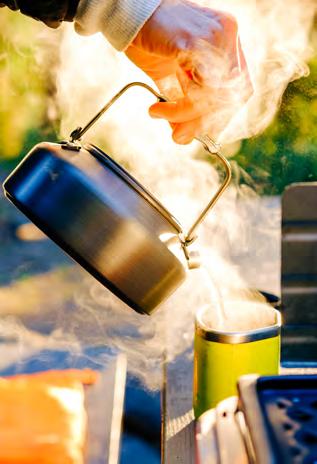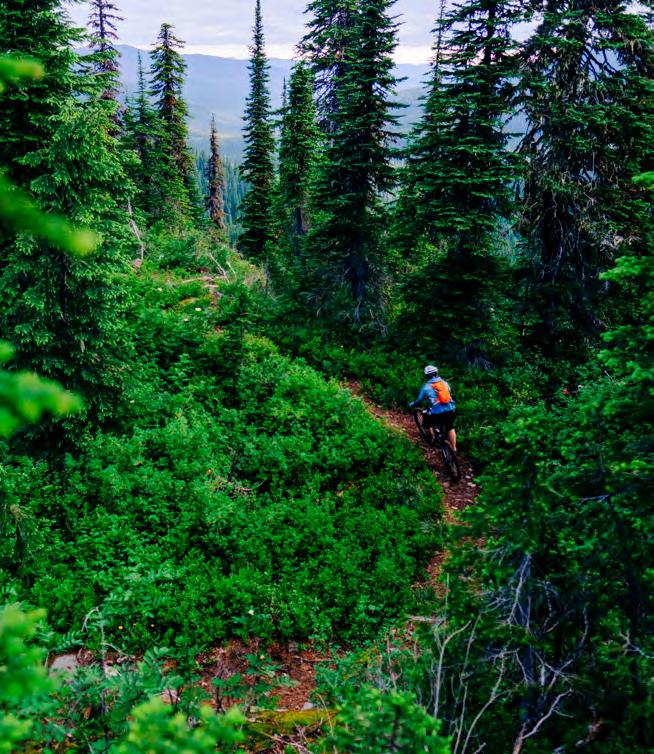
6 minute read
Backcountry MTB Riding in the Yaak
TWENTY MILES OF BOONDOGGLING
BACKCOUNTRY MOUNTAIN BIKING IN THE YAAK VALLEY
BY AARON THEISEN
“HOW MUCH DO YOU PLAN ON RIDING?” the thru-hiker heading the other direction asked. Considering my riding buddy, Erin, and I were currently pushing our bikes uphill, the question seemed loaded.
The short answer: more than was realistic. We’d intended to bike up over Bunker Hill, in northwest Montana’s Yaak Valley, and then continue along the Pacific Northwest Trail to Mount Henry and beyond, through some of the region’s most remote country. But after talking to the Pacific Northwest Trail (PNT) thru-hiker, and listening to our screaming calves, it became clear our ambition was losing a race against daylight. The even shorter answer: “let’s keep boondoggling.”
A few years ago, I was sitting in the Yaak River Tavern—one of two competing watering holes that make up this town in the far northwest corner of Montana—when I struck up a conversation about the area’s lakes with one of the patrons. “Oh it’s just about 20 miles of boondoggling to get there,” he helpfully replied.
It was the first time I’d heard “boondoggle” used as a verb, but it wouldn’t be the last time I’d hear that term, or a variation of it, to describe adventures around the Yaak. Perhaps it’s the thick, trackless timber—the old-growth inland rainforests of the Yaak Valley were one of the flashpoints of the infamous Timbers Wars of the 1980s. Bushwhacking and misadventure are baked into the language.
As Erin and I discovered on our exploratory biking and fishing trip to the Yaak, the riding is legit, with miles of rough, seldom-used trails accessing larch-ringed alpine lakes and loam-filled forests. I’d hiked many of the trails in the region in years past and thought they’d make excellent bike trails, thanks to dreamy soil and long, open ridgelines. Of course, holding imaginary handlebars is a lot different than the real thing.
From a base camp on a bend in the Yaak River, which was quiet even on a long holiday weekend, we’d started our exploration in the Northwest Peak Scenic Area, just south of the Canadian border—as close as us Americans were going to get to BC for the foreseeable future. Hike-a-biking across talus slopes and negotiating narrow, root-strewn sidehills,

UPPER LEFT: BETWEEN ROOTS, STUMPS AND LOAM, THE FORESTS OF THE YAAK VALLEY GIVE RIDERS PLENTY TO WORK WITH. //BOTTOM LEFT: ERIN BERGEY TAKES HER BIKE FOR A WALK ON A TALUS SLOPE NEAR BURKE LAKE. // BOTTOM RIGHT: EVEN IN LATE SUMMER, OVERNIGHT TEMPERATURES IN THE YAAK FREQUENTLY DIP BELOW FREEZING, MAKING PRE-RIDE COFFEE A NECESSITY. // UPPER RIGHT: I BRAKE FOR BEARS: IN THE THICKLY TIMBERED GRIZZLY COUNTRY OF THE NORTHERN PANHANDLE, HOOTING AND HOLLERING ON THE DESCENTS ISN'T JUST FOR FUN. PHOTOS: AARON THEISEN we connected old roads with short stretches of singletrack that accessed high-elevation lakes. At the first of these lakes, we encountered a couple of chatty locals hiking out with the day’s catch.
“There’s so much boondocking to be done up in these mountains,” claimed the husband. Reminded of that years-ago barstool conversation, I instituted it as a mantra for the weekend: do you even boondoggle?
The mantra served us well the next day on the PNT. Faint even by the standards of backcountry Montana, the trail here was more of a suggestion than singletrack, like a thumbnail pressed into an orange peel. After several hours of granny-gear grinding interspersed with hiking, we topped out on Bunker Hill. Acres of gray snags greeted us, as did the tiny lookout tower on Mount Henry well beyond our reach.
Realizing we’d never make it there and back before dark, we settled on a backup plan, shortening our loop with an exit out Fish Lakes Canyon. But we forgot all thoughts of an aborted mission on the descent, where the only thing checking our speed was the need to keep an eye out for grizzlies.
After negotiating the bramble-choked talus slopes of Fish Lakes Canyon, we arrived back in Yaak, desperate for post-ride beverages. Seeing the activity at the Dirty Shame Saloon spilling into the street, and preferring to keep our misadventures to the trail, we didn’t stick around.
The next day, rain awakened us—quite literally, as we had to jump out of the tent to unfurl the rain fly. Things had been uncommonly crispy for a region that’s essentially inland rainforest. Along with much-needed moisture came a wind storm that, as we came to find out, stacked matchsticks of timber on the trails.
That day’s ride, the last of the trip, was otherwise unusually straightforward for the area. A dozen miles west of town, an hourlong gravel grind accesses Redtop, which drops 2,000 feet in two miles and has clearly seen some bike-friendly trail maintenance. After several days of bushwhacking and bike-carrying, we relaxed into an easier riding rhythm, surfing loose duff and shouting “tree!” when the lead rider encountered a downed log. That is, until one downed log turned into three, then four, then an entire stretch of trail buried.
In the Yaak, trees define everything, from the sounds—the ghostly sigh of snags, the disconcerting creaking of leaning trees—to the soft duff of the trail and the glorious shade. They define the economy and the way neighbors, next door but miles apart geographically and maybe politically, interact. They force you under, over, around, and sometimes well off track. They always have the final say, and sometimes what they say is: how much were you planning on riding, anyway? //

Aaron Theisen has contributed to a number of mountain bike magazines, including “Freehub,” “Mountain Flyer,” and “Dirt Rag.” He wrote about biking at Beezley Hill for the November/December issue.

RIDES ON THE WAY TO THE YAAK
The Yaak Valley is famously not on the way to much of anything. But there are plenty of excellent rides on the way there. Below are five that will round out a road trip nicely.
GOLD HILL
This trail, on Bottle Bay, just south of Sandpoint, is one of the area’s venerable closeto-town rides. The trail climbs steadily for three miles through a hardwood forest that wouldn’t look out of place in the Northeast. The descent is quick, with plentiful side hits and root drops. Gold Hill is popular with hikers, dog-walkers, and trail runners; time your ride for off-peak hours.
BRUSH LAKE
Built with bikes in mind and traversing beautiful hardwood forest and open meadows around its namesake lake, the 6-mile Brush Lake loop, north of Bonners Ferry, makes for an excellent shoulder season ride. The free campground and a lake perfect for paddling make it an inviting destination for a summer weekend with tent and bikes in tow.
MINERAL POINT
Situated on a bluff overlooking Green Bay on Lake Pend Oreille, the Mineral Point trail network consists of six miles of cross-country riding amidst a dramatic lakeside landscape. Like Brush Lake the location makes for prime shoulder-season riding. Also like Brush Lake, Mineral Point doubles as a foundation for a bike-centric camping weekend, in this case from a base at Green Bay campground.
RUBY RIDGE
One of the classic backcountry rides of the Idaho Panhandle, Ruby Ridge, north of Moyie Springs, boasts more than 4,000 vertical feet of brake-burning descending over the Moyie River Valley. And with a mostly paved forest road—a rarity in a region of rough backcountry roadbeds—providing access to the trailhead at Keno Pass, it’s ideal for shuttling.
SHELDON MOUNTAIN
Built entirely by locals, the Sheldon Mountain trail, just outside Libby, Mont., offers the town’s only frontcountry riding opportunity. An at-times-grueling five-mile dirt-road climb deposits riders at the communication towers near the top of Sheldon Mountain. From here, two miles and 1,400 vertical feet of descending follow, first on fast sidehill singletrack and then on old roadbed-turned-trail.










